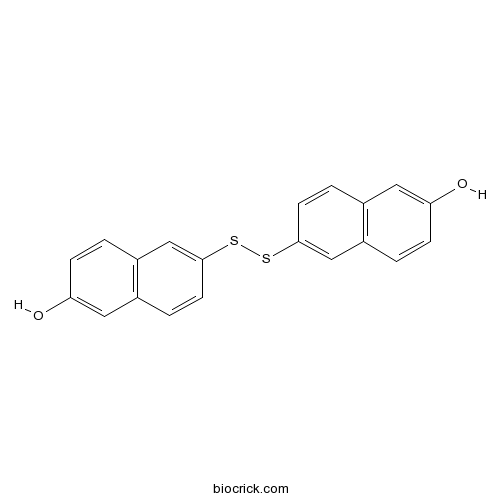PIR 3.5CAS# 6088-51-3 |

- GSK256066 2,2,2-trifluoroacetic acid
Catalog No.:BCC1605
CAS No.:1415560-64-3
- Nortadalafil
Catalog No.:BCC1806
CAS No.:171596-36-4
- Bay 60-7550
Catalog No.:BCC1405
CAS No.:439083-90-6
- Oglemilast
Catalog No.:BCC1817
CAS No.:778576-62-8
- AN-2728
Catalog No.:BCC1361
CAS No.:906673-24-3
Quality Control & MSDS
3D structure
Package In Stock
Number of papers citing our products

| Cas No. | 6088-51-3 | SDF | Download SDF |
| PubChem ID | 22463 | Appearance | Powder |
| Formula | C20H14O2S2 | M.Wt | 350.45 |
| Type of Compound | N/A | Storage | Desiccate at -20°C |
| Solubility | Soluble to 75 mM in DMSO and to 10 mM in ethanol | ||
| Chemical Name | 6-[(6-hydroxynaphthalen-2-yl)disulfanyl]naphthalen-2-ol | ||
| SMILES | C1=CC2=C(C=CC(=C2)SSC3=CC4=C(C=C3)C=C(C=C4)O)C=C1O | ||
| Standard InChIKey | AHXGXXJEEHFHDK-UHFFFAOYSA-N | ||
| Standard InChI | InChI=1S/C20H14O2S2/c21-17-5-1-15-11-19(7-3-13(15)9-17)23-24-20-8-4-14-10-18(22)6-2-16(14)12-20/h1-12,21-22H | ||
| General tips | For obtaining a higher solubility , please warm the tube at 37 ℃ and shake it in the ultrasonic bath for a while.Stock solution can be stored below -20℃ for several months. We recommend that you prepare and use the solution on the same day. However, if the test schedule requires, the stock solutions can be prepared in advance, and the stock solution must be sealed and stored below -20℃. In general, the stock solution can be kept for several months. Before use, we recommend that you leave the vial at room temperature for at least an hour before opening it. |
||
| About Packaging | 1. The packaging of the product may be reversed during transportation, cause the high purity compounds to adhere to the neck or cap of the vial.Take the vail out of its packaging and shake gently until the compounds fall to the bottom of the vial. 2. For liquid products, please centrifuge at 500xg to gather the liquid to the bottom of the vial. 3. Try to avoid loss or contamination during the experiment. |
||
| Shipping Condition | Packaging according to customer requirements(5mg, 10mg, 20mg and more). Ship via FedEx, DHL, UPS, EMS or other couriers with RT, or blue ice upon request. | ||
| Description | Negative control of IPA 3 a direct, non-competitive inhibitor of group I p21-activated kinase (Pak1). |

PIR 3.5 Dilution Calculator

PIR 3.5 Molarity Calculator
| 1 mg | 5 mg | 10 mg | 20 mg | 25 mg | |
| 1 mM | 2.8535 mL | 14.2674 mL | 28.5347 mL | 57.0695 mL | 71.3369 mL |
| 5 mM | 0.5707 mL | 2.8535 mL | 5.7069 mL | 11.4139 mL | 14.2674 mL |
| 10 mM | 0.2853 mL | 1.4267 mL | 2.8535 mL | 5.7069 mL | 7.1337 mL |
| 50 mM | 0.0571 mL | 0.2853 mL | 0.5707 mL | 1.1414 mL | 1.4267 mL |
| 100 mM | 0.0285 mL | 0.1427 mL | 0.2853 mL | 0.5707 mL | 0.7134 mL |
| * Note: If you are in the process of experiment, it's necessary to make the dilution ratios of the samples. The dilution data above is only for reference. Normally, it's can get a better solubility within lower of Concentrations. | |||||

Calcutta University

University of Minnesota

University of Maryland School of Medicine

University of Illinois at Chicago

The Ohio State University

University of Zurich

Harvard University

Colorado State University

Auburn University

Yale University

Worcester Polytechnic Institute

Washington State University

Stanford University

University of Leipzig

Universidade da Beira Interior

The Institute of Cancer Research

Heidelberg University

University of Amsterdam

University of Auckland

TsingHua University

The University of Michigan

Miami University

DRURY University

Jilin University

Fudan University

Wuhan University

Sun Yat-sen University

Universite de Paris

Deemed University

Auckland University

The University of Tokyo

Korea University
- Ligularidine
Catalog No.:BCN2141
CAS No.:60872-63-1
- Crotaverrine
Catalog No.:BCN2142
CAS No.:60827-69-2
- Esculentoside B
Catalog No.:BCN5011
CAS No.:60820-94-2
- Apremilast (CC-10004)
Catalog No.:BCC2273
CAS No.:608141-41-9
- 4-Methoxy-1-methoxycarbonyl-beta-carboline
Catalog No.:BCN1401
CAS No.:60807-25-2
- Lithium Citrate
Catalog No.:BCC3804
CAS No.:6080-58-6
- Sinomenine HCl
Catalog No.:BCN6318
CAS No.:6080-33-7
- Dulcitol
Catalog No.:BCN8153
CAS No.:608-66-2
- 5,7,8-Trimethoxycoumarin
Catalog No.:BCN4125
CAS No.:60796-65-8
- Norbraylin
Catalog No.:BCN4124
CAS No.:60796-64-7
- Berbamine hydrochloride
Catalog No.:BCN2400
CAS No.:6078-17-7
- Quercetin 3-O-beta-D-glucose-7-O-beta-D-gentiobioside
Catalog No.:BCN7821
CAS No.:60778-02-1
- H-DL-Pro-OH
Catalog No.:BCC3026
CAS No.:609-36-9
- 6-Hydroxycoumarin
Catalog No.:BCC9207
CAS No.:6093-68-1
- YZ9
Catalog No.:BCC8001
CAS No.:6093-71-6
- Bz-Glu-OH
Catalog No.:BCC2922
CAS No.:6094-36-6
- Geraniin
Catalog No.:BCN2402
CAS No.:60976-49-0
- 2-Methoxycinnamic acid
Catalog No.:BCN5038
CAS No.:6099-03-2
- Dibucaine (Cinchocaine) HCl
Catalog No.:BCC3760
CAS No.:61-12-1
- Adenosine 5'-monophosphate
Catalog No.:BCC8809
CAS No.:61-19-8
- Papaverine Hydrochloride
Catalog No.:BCC8348
CAS No.:61-25-6
- Mefenamic Acid
Catalog No.:BCC4433
CAS No.:61-68-7
- Phenylephrine HCl
Catalog No.:BCC4335
CAS No.:61-76-7
- 4-Aminohippuric Acid
Catalog No.:BCC4753
CAS No.:61-78-9
An isoform-selective, small-molecule inhibitor targets the autoregulatory mechanism of p21-activated kinase.[Pubmed:18420139]
Chem Biol. 2008 Apr;15(4):322-31.
Autoregulatory domains found within kinases may provide more unique targets for chemical inhibitors than the conserved ATP-binding pocket targeted by most inhibitors. The kinase Pak1 contains an autoinhibitory domain that suppresses the catalytic activity of its kinase domain. Pak1 activators relieve this autoinhibition and initiate conformational rearrangements and autophosphorylation events leading to kinase activation. We developed a screen for allosteric inhibitors targeting Pak1 activation and identified the inhibitor IPA-3. Remarkably, preactivated Pak1 is resistant to IPA-3. IPA-3 also inhibits activation of related Pak isoforms regulated by autoinhibition, but not more distantly related Paks, nor >200 other kinases tested. Pak1 inhibition by IPA-3 in live cells supports a critical role for Pak in PDGF-stimulated Erk activation. These studies illustrate an alternative strategy for kinase inhibition and introduce a highly selective, cell-permeable chemical inhibitor of Pak.


